A number of comprehensive test reports have been published on the Nikon D800E. The image quality of this camera has triggered shootouts with medium format systems such as the Leica S, Hasselblad H4D, and the Mamiya/Leaf combo.
To me, these evaluations were not really conclusive, as they focus mainly on resolution and often propose pixel peeping on a low-gamut LCD screens. In discussion forums, these tests have consequently drawn comments that it would be illicit to “compare apples and oranges” and that there are “horses for courses”. Such comments are triggered by the real-world decision-making problems featuring multiple conflicting objectives. The best conceived test is useless if the methodology is not sound and the criteria are not clearly defined. But more importantly any such test will be highly subjective with inherent, strongly weighted objectives.
Therefore, I must explain first my shooting style and preferences, workflow, and photographic background. For me, the definition of an outstanding image boils down to a simple question: wouldn’t I mind spending big bucks on printing and framing of an image, displaying it in my home, and looking at it for hours on end? For me, as a scientific engineer, technical perfection is an important aspect. Any of my keeper images qualify for a 60×80 cm (23”) fine art print, holding up 10″ viewing distance. This is what I call supernatural, because the print reveals details that at the location were not visible to the naked eye. I thus spare no effort; when I visualize an image at a remote place, which I might be able to visit only once in a lifetime, I just want to have the best equipment with me. And leaving aside the artistic aspect of photography, if something goes wrong technically, it will be my, and not the equipment’s fault.
Coming from a used Nikon F2, I soon switched to large-format, 4×5” view cameras. Over the years, my equipment has included Linhof Technika and Technikardan Cameras and lenses from 27 to 150 mm, on 35 mm equivalent. In the film days the equation was easy, given a relatively limited choice of film material, bigger was better. And the optical quality even of the older large-format lenses was excellent.
In recent years, however, I have seen the classical photographic enlargements disappear (and with it my beloved Cibachrome polyester prints), Kodak on Chapter 11, film no more on stock at local stores, and Quickload (Fuji) and Readyload (Kodak) film sheets discontinued. I have gotten film x-rayed to death at security checkpoints, was harassed for setting up a tripod, had difficulty in finding a quality lab for film development, and had to send my images across the Atlantic for quality drum-scanning.
However, film pulls out about 2400 dpi worth of information per inch, which corresponds to 8 Megapixel for 36 mm and an impressive 115 MP for a sheet of 4×5”. But the perceived image quality is not only about spatial resolution; it is to a large extent related to tonality (color gamut and tonal separation) and micro-contrast (details in structures that are close together in luminance). And here film still has an edge even at smaller, medium format, sizes.
Until May 2012 I considered digital cameras, point-and-shoot as well as DSLR, as mere electronic notebooks. Low dynamic range (blown highlights or closed shadows), narrow color gamut, and low spacial resolution made printing even at 17” pointless. I bought my first digital camera, a Canon Ixus, in 2003 and added a Nikon D200 in 2006. None of the images I took with this equipment has found its way into my portfolio. Color shifts were difficult to correct because of the 12-bit limitation. Moreover, I saw these cameras (and the storage media) being outdated not even two years after the purchase; I already wasted more money on digital cameras than on the entire large-format outfit. And I am sure that the Linhofs will be working just fine, as long as we can still buy sheet film, in another 20 years; I am just as sure the present digital cameras won’t be.
The 36 MP Nikon D800E turned out to be a game changer, however. I ordered the camera the day after it was announced, and received the third model sold by Calumet in Munich. A couple of aspects became evident with the first test shots: the E version has a clear advantage in pixel acuity, moiré is not an issue (I am not shooting weddings and fashion), and the camera is very demanding on lenses; every optical flaw is revealed. So, best glass must be combined with a very stringent shot discipline.
I took the Nikon, along with my 4×5 equipment, to Ladakh, Myanmar, and the USA. I carried over to the DSLR the shooting discipline I had learned from using the large format equipment; setting up my sturdy Gitzo tripod, composing and focusing with live view, and using the self-timer with a three seconds delay between mirror up and shutter release. Digital capture offers several advantages with respect to film, most notably the dynamic range of about 12 stops for color images. And the instant review capabilities allow achieving precise focus, depth of field, and exposure. If used with taste, a variety of digital darkroom techniques, such as exposure blending, focus stacking, and image stitching can help to improve the image quality. This post processing is possible, in principle, also with scanned film, but at an insane price; here in Europe I must count about $ 10 for each shot, without scanning! The resolution of the D800E is sufficient for a 23” print, although I would consider this as an upper limit. Output sizes below 200 dpi yield blurred images whereas uprezing results in digital artifacts and washed out surfaces.
What I am still missing from the D800E is the tonal separation and micro-contrast that (large format) film can deliver. Moreover, having worked almost exclusively with the 4×5, I still have problems to adapt myself to the 2/3 ratio of the DSLR. I just can’t fill the frame.
For a long time, medium-format digital backs with CCD sensors separated themselves from 35 mm digital cameras by a huge gap in image quality and resolution, albeit the tenfold price. But seeing the digital back manufacturers turn away from CCD to a Sony sensor with CMOS architecture, similar to the one in the D800E, I considered it high time to go for a test drive. I was not looking forward to spend in the two-digit, k$ range, but I really wanted this medium-format combo to work out for me. Mainly because the Leaf Credo back can be mounted on the view camera, which would bring me back the joy of full tilt-shift functionality.
So I was all excited when I unboxed what Calumet Munich had sent me for a weekend: A Mamiya 645d with a 80 mm Schneider leaf-shutter lens, a Leaf Credo 60 MP digital back, a Linhof leveling head, and a Cambo WRS equipped with a 43 mm Schneider digitar lens, featuring a 110 mm image circle. The Mamiya system retails at around $ 31 k without tax, while the Cambo adds another $ 5 k including tax, but without the lens.
The 645DF is an open platform, digital-only, medium format camera that (nearly) handles like a 35mm SLR, but with a large image area of 56 x 41.5 mm. When used with one of Schneider LS D lenses it allows you to choose between the integral focal plane shutter and the leaf shutter, which can achieve flash sync speeds up to 1/1600 s.
The Leaf Credo digital back is built like the proverbial tank, weighing 560 g. It is easy to mount and has a large (3.2”), bright, and high-resolution (1.15 MP) touch screen LCD (Nikon D800E: 3.2”, 0.921 MP). Just like the Iphone, the Credo has a very clear menu structure, reduced to the minimum. With this setup I did not mind having to change ISO settings through the menu. The argument against the touch screen is the use of a viewing loupe, an argument that may hold for filming but definitely not for still photography. The first hiccup as regards the screen is that it cannot be switched off completely. When using the viewfinder, I found the light emitted by the screen irritating. The sensor is recessed from the flange by only a few millimeters, which enables mounting it on a view camera, makes the sensor easy to clean but also easy to scratch. The Credo 60 MP digital back houses a 53.9×40.4 mm DALSA CCD sensor with 6-micron pixel size and a color depth of 16 bit. The 60 MP is the largest sensor in the Credo lineup and is said to provide a crop factor of 1; this may be true in the digital world but let us not forget that “real” medium format is 6×7, 6×6, and 6×4.5 cm.
The camera itself is made from an aluminum-magnesium alloy and has a solid feel, except for the grip that is too small for my hands, and for the weight of the combo. The grip is entirely made of plastic and lacks the haptic and tactility that I would expect for this price. The dials are almost DSLR like and thus self-explaining. The view finder is bright and huge, and can thus be used for manual focusing. With the Nikon it is like looking into a dark tunnel, in comparison.
Shooting in portrait orientation, which holds for about 80% of my images in the 4×5 aspect ratio, you will find that the Mamiya simply isn’t designed for that, and it is physically very difficult to accomplish. Too bad that there is no revolving back or a second tripod socket like on the Pentax 645D. The back and the camera run on two different batteries; this wouldn’t be a problem if only they were interchangeable or could, at least, be charged in the same station. But the two different charger stations with cable and plug adapters accumulate to about half a kilogram of useless bulk. The camera’s focus system can only be set for left, right, or center, within a very limited range, a far cry from the Nikon systems with its 55 selectable points.
The Mamiya/Leaf combo offers 50-800 ISO sensitivity, 1/10,000 – 60 seconds exposure time, and a capture rate of 1 fps (Nikon D800E: 50-25600 ISO sensitivity and 1/8000 – 30 seconds, 4 fps). If the maximum burst rate matters to you, the medium format system will be out of the question. But then, if the photography sucks at 1 fps, it will suck twice at 2 fps.
At first impression, the lens retailing at about $ 3 k is a no-go, with a plastic barrel and hood that doesn’t snugly lock into place. And the autofocus motor, surprisingly slow, sounds like a washing machine. The lens weighs only 450 g, which could be an advantage, but it also makes the combo unbalanced because of the heavy Credo back. I was told that the leaf shutter requires such a light-weight construction for the autofocus motor to cope with. Optically, though, there is nothing left to desire; the lens is sharp to the corners from around f4 and usable up to aperture 16 before diffraction sets in. In this respect the D800E is much more demanding. Most lenses work best in only a short range from f4 to f8 and are quickly diffraction limited above.
I was a bit wary about the tests by DxOMark ranking the Sony sensors in the D800E and the Sony A7R cameras at 95 points, while the Dalsa CCD sensor in the Phase One IQ180 scores at 91 points only. The downgrading of the CCD sensor stems from the performance limitations at high ISO, although I would be careful with ISO settings above 800 on the Nikon also, after which some aggressive in-camera noise reduction sets in. Moreover, the Nikon looses about one stop of dynamic range for each increment from base ISO 100. Still, I am happily shooting outdoor portraits at ISO 400 to arrive at shutter speeds well below the reciprocal of 2-3 times the focal length. The dynamic range of both sensors is about equal, with an edge for the Nikon, which also shows better shadow recovery, while the Credo 60 has more latitude and a smoother transition into the highlights.
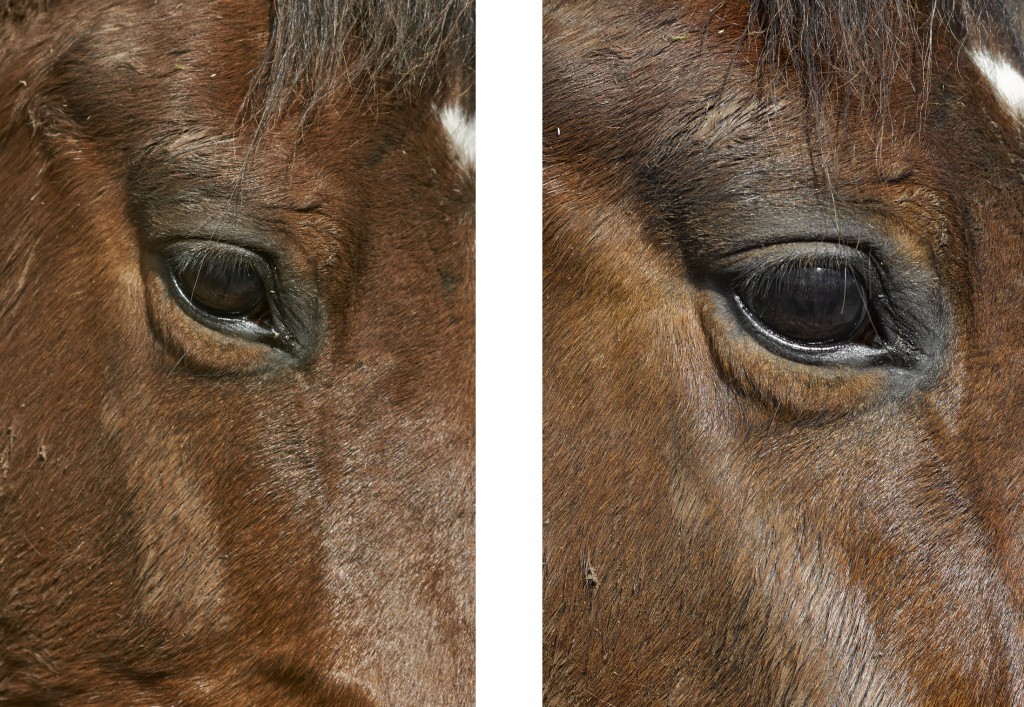
Left: Nikon D800E with 70-200 f2.8 VR II at 80 mm focal length. Right: Mamiya-Leaf Credo 60 with Schneider 80 mm.
The medium format system is not made for action, and it has never claimed to be. The horse portrait shown above turned out sharp at almost 100% using the Nikon with the fast-focusing 70-200 f2.8 VR II zoom lens, which is my preferred lens for portraits. Using the Mamiya/Leaf combo I had only a few keepers, mainly due to the inferior focusing system with only one focus point. “Focus and recompose” is neither fast nor precise for the resolution of the modern sensors. The focusing system on the medium format camera was very well calibrated, but I did not check if this was because of tight manufacturing tolerances or because of careful calibration by Calumet.
When the Mamiya/Leaf combo delivers, there is a clear advantage stemming from the larger sensor real estate. There is a better tonal separation in the horse’s fur and a smoother transition into the highlights, although the white spot is blown out due to the slightly lower dynamic range of the Credo. This higher color rendering accounts for “three-dimensionality” of medium format images, which is often attributed to the smoother transition into the out-of-focus areas. In the Credo image, finer detail is visible and it is freer of the digital sharpening halo that is operating so obviously on the image on the left; and which cannot be disabled even when shooting RAW. Here lies the problem of digital capture in general: Do you ever shoot eyelashes as a subject in the normal course of photographing? Because of the relatively small capture area, the camera makers force on us aggressive digital sharpening (and noise reduction). This may be less true for the professional backs, as we see in this example.
DxOMark attributes almost the same marks for color depth (25.6 points for the Nikon, 26.5 for the IQ180), which looks strange given the results from the horse portrait (except if we were seeing a flaw in the 70-200 zoom lens rather than a difference in the sensor architecture). So for the next example I set out for the trees, mainly because the high frequency details tend to break up the images at the micro level, which then results in lost midtone richness. Desert landscapes would have been even better, but are (fortunately) not accessible in this part of the world. I mounted both cameras on separate tripods to be able to shoot within seconds in the same light. I equipped the Nikon with the 45 PC-E tilt-shift lens, which is Nikon’s finest lens in this focal range. However, the 45 PC-E has visibly more lateral chromatic aberrations than the 80 mm Schneider LS. I disregarded the different view angles of the lenses, avoiding the lens issue solely for arriving at the same perspective. Both cameras were shot in RAW at base ISO (50 for the Credo, 100 for the Nikon) and processed with the Capture One software from Phase One.
Not surprisingly, the Capture One software offers more tonal curves for the digital back than for the Nikon. But also for the latter, I obtain more pleasing results from that software compared to Nikon’s genuine Capture NX2. Using the same curves, i.e., low contrast portrait, the results from both cameras are lacking color accuracy, the auto white balance of the Nikon being consistently cooler than for the Credo. The Nikon also shows a pronounced shift into the magenta, while the Credo lacks saturation in the blue channel. With the standard settings, the Nikon images are overall more saturated, yet I consider this closer to the visual impression at the spot. Heavy tweaking in Photoshop yields the results shown here.
An intrinsic advantage of the digital backs is that they can be mounted on view cameras. The beautifully engineered Cambo WRS body allows 40 mm lens shift both in lateral and vertical directions together with 4-way stitching possibilities. It allows mounting lenses from 23 to about 150 mm focal length without a bellows and takes mounting plates for Hasselblad, Leaf, and Phase One digital backs. The back is triggered through a cable connected to the flash-sync port of the (Copal) leaf shutter lenses and by setting the back to “zero latency”. Although this setting increases the power consumption of the back, it is always prepared for exposure. Using the somewhat lagging live view on the Credo circumvents focusing on the ground glass. But be careful, at open aperture and in bright light the CCD sensor runs into saturation and therefore either a neutral density filter must be mounted, or the aperture must be stopped down.
Here lies an advantage of the CMOS sensor; I had no such issue when mounting the D800E on my Linhof using the Photodiox adapter. Although this setup works in principle, the flange focal distance of the Nikon F-mount (46.5 mm) plus the space needed to accommodate the hand-grip and the compressed bellows of the view camera, makes this setup completely useless for focal lengths below 90 mm. Moreover, the largest apertures of my large-format lenses are between f5.6 and f9, which yields very little margin to the diffraction limit.
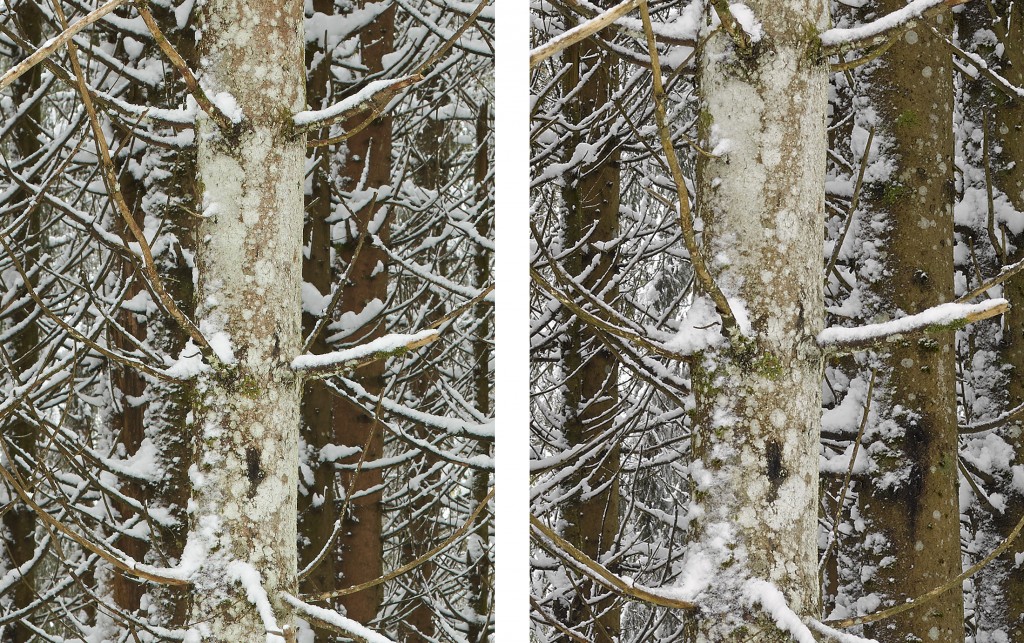
100% crop of the above. No extra sharpening applied in Photoshop but heavy tweaking for color balance and contrast. Left: Nikon D800E. Right: Mamiya/Leaf. Click to enlarge.
As enjoyable as it was to work with this equipment, given its price tag, the Mamiya/Leaf combo is definitely not for the amateur. These days, large-format film cameras can be had on a shoestring and the savings can pay for a lot of film, development, and scanning. In the meantime we can wait for DSLRs with larger signal-to-noise ratios allowing for a genuine 16-bit sampling. In my opinion, we are already close to the end of the megapixel race. In landscape photography there will be the stitching option to increase the tonal richness or if larger prints are required; anyhow, there is limited wall space in most private homes. We can also hope for a price reduction on the medium-format CMOS backs, just in time before film becomes completely unavailable.
With such a close run between the 60 MP Leaf Credo CCD and the Nikon/Sony 36 MP CMOS sensors I am convinced there lies more potential in the lenses. Reports on the Zeiss Otus Distagon 55 mm seem to suggest that micro-contrast and tonal separation can be found right there.
Time for another shootout.
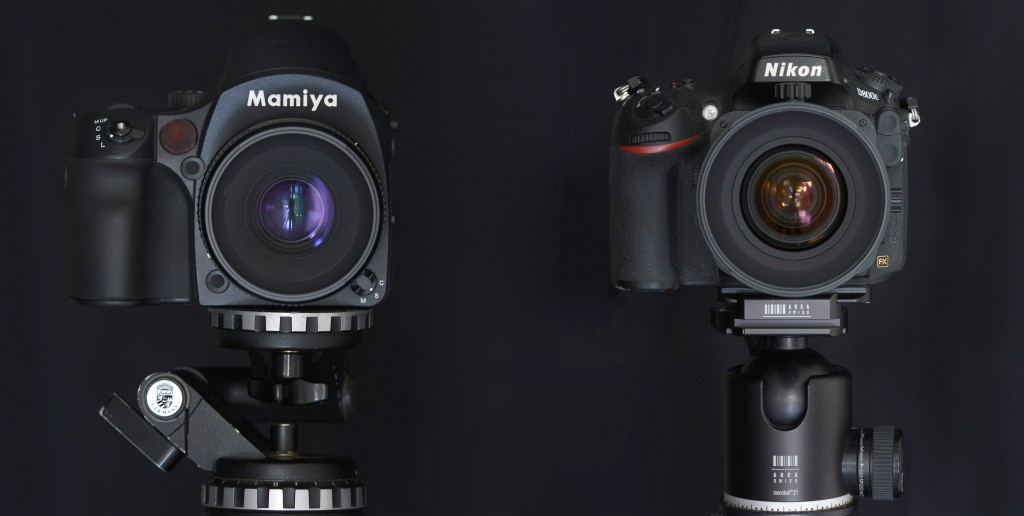
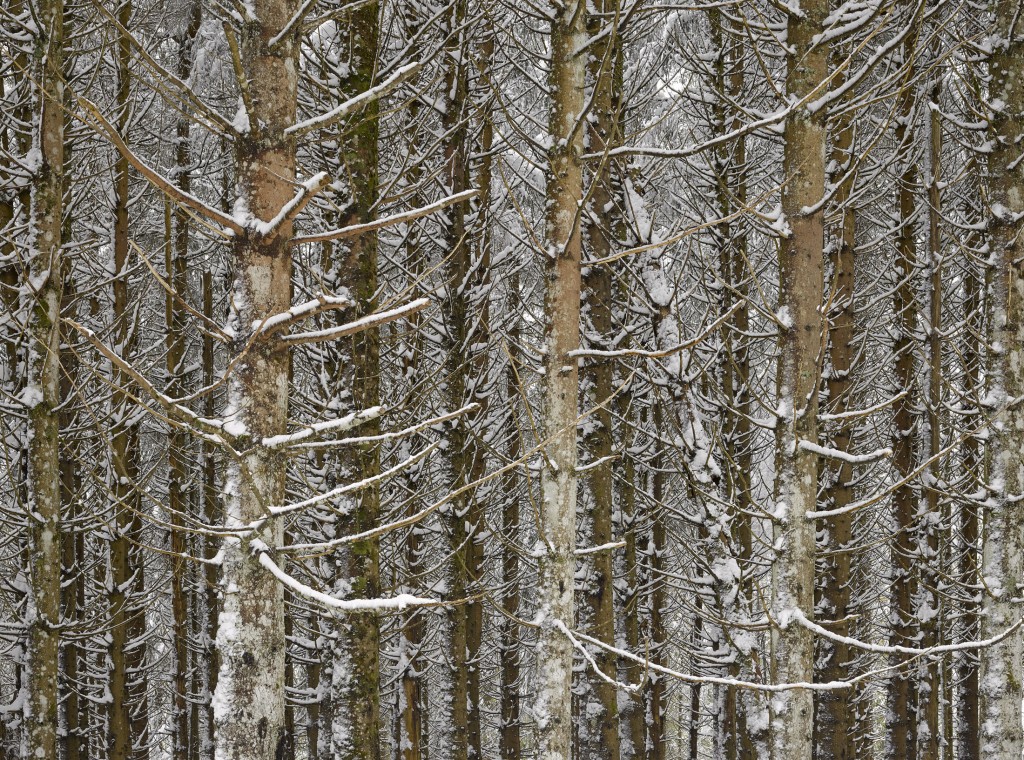
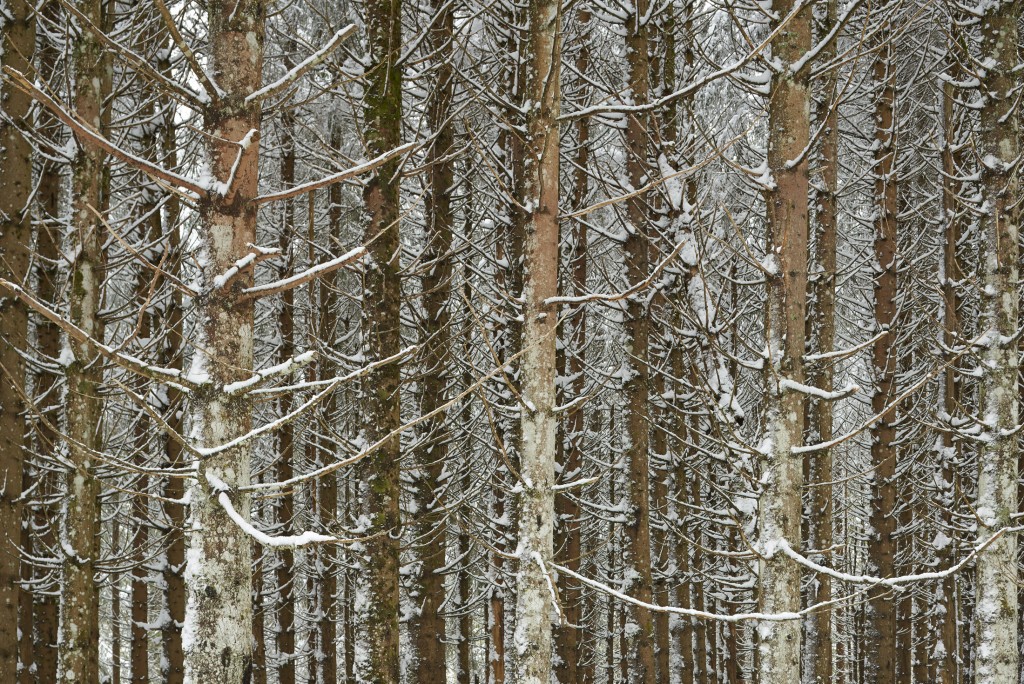
9 Comments
Hello, I would like to subscribe for this website to obtain newest updates, therefore where can i do it please assist.
You can click on the relevant categories at the end of each post.
I would realley like to know how you would like ” to descibe …the look” of a D810 compared to a phase one image when both printed with the appropriate ” adjustments”… using capture one conversion ( if possible) and is the purchase of a phase one ” significant enough” in terms of appearance?
As you mention the D810; I recently purchased a D810 because I needed a second body. The D810 has improved somewhat in tonality, in particular in the highlights, which closes the gap to the CCD sensors even more. Recently, Phase have converted to the Sony CMOS sensors themselves, so there is no reason per se, why there should be a different “look” (though they claim a true 16 bit workflow). Catering for the pro market there is less in-body cooking of RAW files and obviously the profiles provided for Phase cameras in CaptureOne Pro have gotten more attention than profiles for third party cameras.
But what I find exciting is the 100 MP back recently announced. Not that I want/can spend the money, but it shows where technology is heading. Let’s wait another 2-3 years.
As a shooter of digital (with Nikon D810 with zeiss lenses and Leica with M8.2 with Leica lenses) and film with Hasselblad 500 series, I frecuently find myself with the question: where do i put my money? MF sensors and lenses or high end 35 mm lenses like the Otus, I shoot portrait and landscape, articles like yours, specially with the photography examples, help me a lot to clarify the way, thanks.
If only the Otuses were F2.0 instead of F1.4. This set of three is really too heavy to haul into the mountains. But in general, good glass is an investment, while cameras have become dispensable items. Think about a full frame (in 35 mm standards) Foveon sensor with about 30 MP per layer. Or a medium format mirrorless. I for my part will wait a year or two before I upgrade.
Thanks for the comparison. This is very interesting especially in light of the Pentax 645Z coming out at $8500, wondering if the lens quality of the pentax will make it worth the price gap of the Canon/Nikon with the Otus/Art quality lenses.
Adam
I expect the same tonal separation and pixel acuity as for the Nikon, albeit with more sensor real estate and my preferred aspect ratio of 4:3. Although there is an impressive lens line-up to boot, I read mixed comments about the Pentax glass. As the medium format cameras will never be speed demons, I think the time is ripe for a mirrorless solution featuring that 50 MP, 44 x 33 mm Sony sensor, allowing to mount vintage medium-format lenses with the appropriate adapters (I will post some tests on ray angle and color-shading issues soon). The shorter flange focal distance of a mirrorless would make an adapter solution to large format (Grafloc back) feasible, which is excluded for the Pentax 645Z with its 70.8 mm mirror box. So I don’t think that I will invest into the Pentax system; this would be different if I had not bought Nikon’s “holy trinity” of lenses, among others, only two years ago.
Hi Adam, today Ming Thein posted on a discussion with Lloyd Chambers on the D810 and the Pentax 645Z. http://blog.mingthein.com/2014/07/25/discussions-mt-x-lloyd-chambers-on-the-pentax-645z-and-nikon-d810/. It seems that the sensor cannot make up for the Pentax lens quality. And the Otus is truly amazing as I could find out myself on a recent visit to Zuerich.
One Trackback
[…] comparison is from a few years ago but is still interesting. A recommended […]